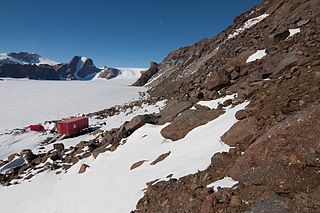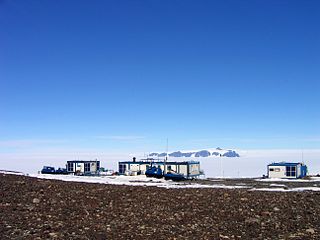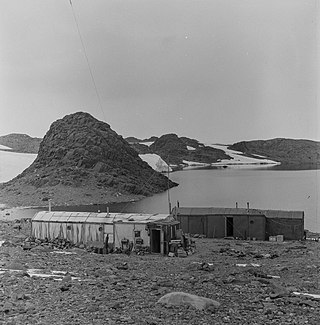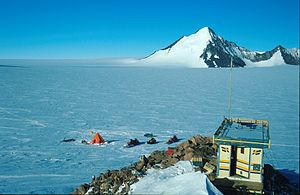Transport in Antarctica has transformed from explorers crossing the isolated remote area of Antarctica by foot to a more open era due to human technologies enabling more convenient and faster transport, predominantly by air and water, but also by land as well. Transportation technologies on a remote area like Antarctica need to be able to deal with extremely low temperatures and continuous winds to ensure the travelers' safety. Due to the fragility of the Antarctic environment, only a limited amount of transport movements can take place and sustainable transportation technologies have to be used to reduce the ecological footprint. The infrastructure of land, water and air transport needs to be safe and sustainable. Currently thousands of tourists and hundreds of scientists a year depend on the Antarctic transportation system.

The polar regions, also called the frigid zones or polar zones, of Earth are Earth's polar ice caps, the regions of the planet that surround its geographical poles, lying within the polar circles. These high latitudes are dominated by floating sea ice covering much of the Arctic Ocean in the north, and by the Antarctic ice sheet on the continent of Antarctica and the Southern Ocean in the south.

Showa Station, sometimes alternately spelled Syowa Station, is a Japanese permanent research station on East Ongul Island in Queen Maud Land, Antarctica. Built in 1957, Showa Station is named for the era in the Japanese calendar during which it was established, the Shōwa period.

The Mirny Station is a Russian first Antarctic science station located in Queen Mary Land, Antarctica, on the Antarctic coast of the Davis Sea.

The Pole of Inaccessibility research station is a defunct Soviet research station in Kemp Land, Antarctica, at the southern pole of inaccessibility as defined in 1958 when the station was established. Later definitions give other locations, all relatively near this point. It performed meteorological observations from 14 to 26 December 1958. The Pole of Inaccessibility has the world's coldest year-round average temperature of −58.2 °C (−72.8 °F).

Troll Airfield is an airstrip located 6.8 kilometres (4.2 mi) from the research station Troll in Princess Martha Coast in Queen Maud Land, Antarctica. Owned and operated by the Norwegian Polar Institute, it consists of a 3,300-by-100-metre runway on glacial blue ice on the Antarctic ice sheet. The airport is located at 1,232 metres (4,042 ft) above mean sea level and is 235 kilometres (146 mi) from the coast.
The British Antarctic Survey (BAS) is the United Kingdom's national polar research institute. It has a dual purpose, to conduct polar science, enabling better understanding of global issues, and to provide an active presence in the Antarctic on behalf of the UK. It is part of the Natural Environment Research Council (NERC). With over 400 staff, BAS takes an active role in Antarctic affairs, operating five research stations, one ship and five aircraft in both polar regions, as well as addressing key global and regional issues. This involves joint research projects with over 40 UK universities and more than 120 national and international collaborations.

Tor research station is a Norwegian Antarctic research station in Queen Maud Land.

The Lower Erebus Hut (LEH) is a permanent field facility located on Mount Erebus on Ross Island, Antarctica. The hut served as the seasonal base of the Mount Erebus Volcano Observatory (MEVO), run by New Mexico Institute of Mining and Technology (NMT). The installation comprises two huts, one kitchen and recreation building and one working and storage building.

The Nordenskiöld Base is a name used for the facilities shared by the Antarctic stations Wasa (Sweden) and Aboa (Finland). The name is in honors Otto Nordenskjöld, a Finnish-Swedish polar explorer who led the first Swedish Antarctic Expedition.

The Great Wall Station is the first Chinese research station in Antarctica and opened on 20 February 1985. It lies on the Fildes Peninsula on King George Island, 960 kilometres (600 mi) from Cape Horn. It is sited on ice-free rock, about 10 metres (33 ft) above sea level.
The Jinnah Antarctic Station is a summer-only active Antarctic research station operated by the Pakistan Antarctic Programme. Located in East Antarctica, it lies in the vicinity of the Sør Rondane Mountains in Queen Maud Land, and is named after Muhammad Ali Jinnah.
Kunlun Station is the southernmost of five Chinese research stations in Antarctica. When it is occupied during the summer, it is the second-southernmost research base in Antarctica, behind only the American Amundsen–Scott South Pole Station at the geographical South Pole. When Kunlun is not in operation, the year-round Russian Vostok Station is the second-southernmost base in Antarctica.

Aboa is a seasonal Finnish research station in Antarctica, located in Queen Maud Land, about 130 kilometres (81 mi) from the coast, on a nunatak called Basen in the Kraul Mountains.

Queen Maud Land is a roughly 2.7-million-square-kilometre (1.0-million-square-mile) region of Antarctica claimed by Norway as a dependent territory. It borders the claimed British Antarctic Territory 20° west and the Australian Antarctic Territory 45° east. In addition, a small unclaimed area from 1939 was annexed in June 2015. Positioned in East Antarctica, it makes out about one-fifth of the continent, and is named after the Norwegian Queen Maud (1869–1938).

Prem Chand Pandey is an Indian space scientist, planetary scientist, and academic in the fields of satellite oceanography, remote sensing, atmospheric science, the Antarctic and climate change, and also he is the founding director of the National Centre for Polar and Ocean Research (NCPOR).

The Swedish Polar Research Secretariat is a government agency in charge of coordinating and promoting Swedish polar research activities. It is located in Stockholm, has more than 30 employees, and serves under the Ministry of Education and Research.
Bharati is a permanent Antarctic research station commissioned by India. It is India's third Antarctic research facility and one of two active Indian research stations, alongside Maitri. India's first committed research facility, Dakshin Gangotri, is being used as a supply base. India has demarcated an area beside Larsemann Hills at 69°S, 76°E for construction. The research station has been operational since 18 March 2012, though it is still being run on trial basis and formal launch is awaited. Since its completion, India has become one of nine nations to have multiple stations within the Antarctic Circle. Bharati's research mandate focuses on oceanographic studies and the phenomenon of continental breakup. It also facilitates research to refine the current understanding of the Indian subcontinent's geological history. News sources have referred to the station as "Bharathi", "Bharti" and "Bharati".

A.B. Dobrowolski Polar Station is an occasionally active Polish polar research station in Antarctica. It is located at the edge of the Algae Lake, Bunger Hills region in the Wilkes Land and was originally constructed by the Soviet Union. It is one of the two Polish stations in Antarctica, the other being the Henryk Arctowski Polish Antarctic Station.
The Wasa Research Station is a Swedish research facility in Antarctica, established in 1988/1989. It is situated next to the Finnish Aboa Research Station on the Basen nunatak in the Kraul Mountains in Queen Maud Land. The two stations cooperate, and are jointly referred to as the Nordenskiöld Base Camp.















